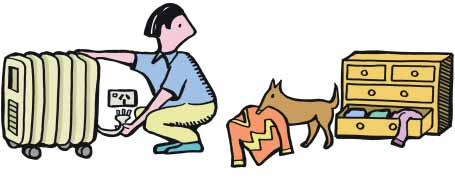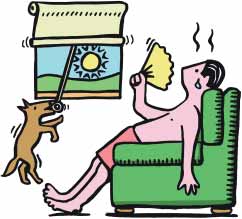Home heating
and cooling
Dress
appropriately for the weather: put
on a jumper before turning on a heater,
and take
off excess clothes before using an airconditioner
T he
energy used for heating and cooling a typical home generates more
than one and a half tonnes of greenhouse gas and costs more than $200
each year.
he
energy used for heating and cooling a typical home generates more
than one and a half tonnes of greenhouse gas and costs more than $200
each year.
In a cool climate, a large house with central
heating could produce 10 tonnes or more of greenhouse gas and cost
more than $1,000 to heat each year.
How can I help the environment and
save $
Make your home more efficient: Limit the flow of heat through your
roof, walls, windows and gaps.
Insulate
ceiling, walls and floors. As much as 35% of heat loss from
a house is through an uninsulated ceiling; uninsulated walls account
for a further 15 to 25% and uninsulated floors lose between 10 and
20% of heat.
Blinds
and curtains should have white or reflective outer surfaces—dark
colours absorb solar energy, adding to cooling problems.
Place
rugs or carpets on timber or elevated slab floors.
Cover
internal walls, particularly those that face south. Even a large
woollen wall hanging can provide extra insulation, reducing heat
loss in winter.
Only
heat rooms you are using and close doors between the heater and
unoccupied rooms.
Fully
insulating your home can halve heating and cooling greenhouse gas
emissions and costs and dramatically improve comfort all year.
Windows
are the weakest point of most houses. In winter a window can lose 10
times as much heat as the same area of insulated wall. In summer,
each square metre of glass exposed to sun can gain nearly as much
heat as running a single bar radiator.
In
winter, close fitting blinds or curtains that create a layer of
still air next to the glass are most effective. External shading is
twice as effective as an internal blind at blocking out summer heat.
Unshaded
skylights and roof glazing can overheat in summer and lose heat in
winter.
Cool your home efficiently
O n
mornings of hot days, close
up the house and shade all windows
to block out the summer heat. When it cools down outside, open up the
house to breezes.
n
mornings of hot days, close
up the house and shade all windows
to block out the summer heat. When it cools down outside, open up the
house to breezes.
Use
Ceiling fans
Air
Conditioners are not energy efficient but if you must ~ use in
combination with ceiling fans~ they create a “wind chill
effect,”
using
a ceiling fan allows your air conditioning system to use 20 to 50%
less energy to cool your home. While there is an energy cost to
run ceiling fans, they typically use approximately 40 to 50 watts,
Average residential Air Conditioner daily energy consumption
is 25 KWh or about 1 KWh per hour.
Clean
filters of airconditioners as recommended by the manufacturer:
a clogged filter reduces air flow and efficiency.
In
climates with dry heat, evaporative coolers provide comfort while
using as little as a tenth of the energy of an airconditioner with
much lower greenhouse gas emissions.
In
hot humid climates, when you need cooling use a high efficiency
refrigerated air conditioner. Airconditioners carry energy labels so
you can compare their performance. B8_s8.1
Heat your home efficiently
Seal
out draughts by sealing cracks and gaps around doors, windows and
skirting boards, fitting dampers to fireplaces and open exhaust
fans, and blocking unnecessary vents: cut annual greenhouse gas
emissions by hundreds of kilograms and improve comfort.
Select
a low greenhouse impact source for heating Reverse cycle
airconditioners and gas heaters carry energy labels to help you
choose an efficient model. www.energyrating.gov.au.
If
using a wood heater, use only dry, seasoned wood,
and operate according to manufacturer’s instructions to
minimise pollution. Consider switching to another option.
Leaving
heating or cooling running when no-one is home generates more
greenhouse gas and costs more money. Timer controls can switch
equipment on when it’s needed.
A
thermostat setting of 18–20°C in winter, or 26oC in summer
is usually comfortable. An extra 1oC difference in temperature
between indoors and outdoors can add around 10% to heating or
cooling costs and greenhouse gas emissions.
Insulate
the ceilings ~ use insulation made from recycled materials
greenhouse
gas emissions for heaters
|
•
|
Consuming
1kWh of electricity from electricity grid emits approximately 0.99
kg of carbon dioxide, the main greenhouse gas.
|
|
•
|
Consuming
1kWh of natural gas emits approximately 0.21 kg of carbon dioxide
equivalent.
|
|
•
|
Consuming
1kWh of LPG emits approximately 0.22 kg of carbon dioxide
equivalent.
|
|
•
|
Consuming
1kWh of kerosene emits 0.24 kg of carbon dioxide equivalent.
|
|
•
|
Consuming 1kWh of
wood emits 0.34 kg of carbon dioxide. If the wood is sustainably
regrown the new tree absorbs this carbon dioxide making the fuel
greenhouse neutral (ignoring transport emissions). Woods
energy content is 4.5 kWh/kg or 16.2 gigajoules/tonne (GJ/t)
|
•
Ducted gas heaters operate with an efficiency of 51% to 87%, which
is derived from the Australian Gas Association's January 2001
'Directory of Certified Gas Appliances and Components'. An
additional allowance has been made for duct losses and electricity
use (eg fan use).
•
Flued gas heaters operate with an efficiency of 60% to 88%, which
is derived from the Australian Gas Association's January 2001
'Directory of Certified Gas Appliances and Components'. An
additional allowance has been made for electricity use (eg fan use).
• In
floor electric and radiant panel electric heaters operate with an
efficiency of 80% to 90% due to heat losses through the floor (in
floor electric) and ceiling and walls (radiant panel electric)
•
Open fireplaces operate at an efficiency of 10% to 15%, with the
majority of heat lost up the chimney
•
Slow combustion wood heaters operate at an efficiency of 65% to 75%.
•
Portable electric heaters operate at an efficiency of 100%.
•
Portable gas heaters operate at an efficiency of 82%. This includes
an allowance for increased ventilation requirements and electricity
use (eg fan use).
•
Portable kerosene heaters operate at an efficiency of 75%. This
includes an allowance for increased ventilation
requirements.
B8_s8.2
 he
energy used for heating and cooling a typical home generates more
than one and a half tonnes of greenhouse gas and costs more than $200
each year.
he
energy used for heating and cooling a typical home generates more
than one and a half tonnes of greenhouse gas and costs more than $200
each year.  n
mornings of hot days,
n
mornings of hot days,